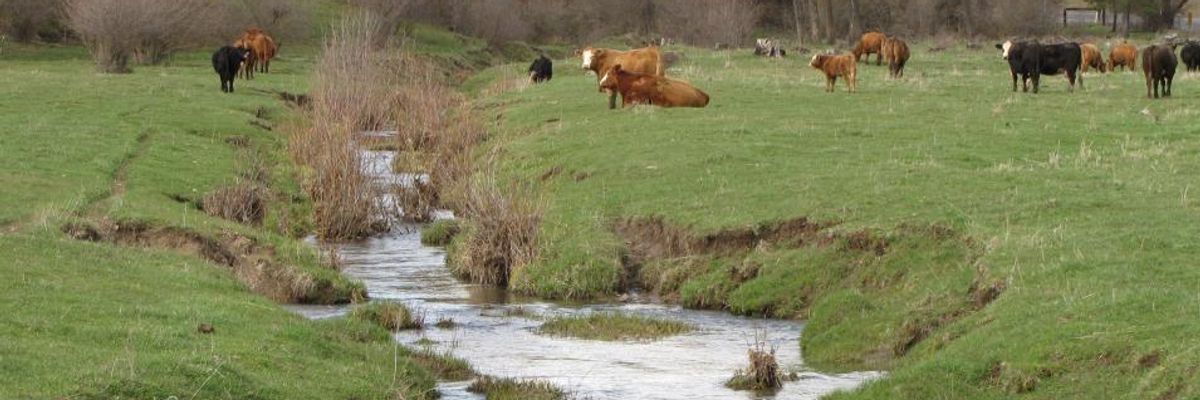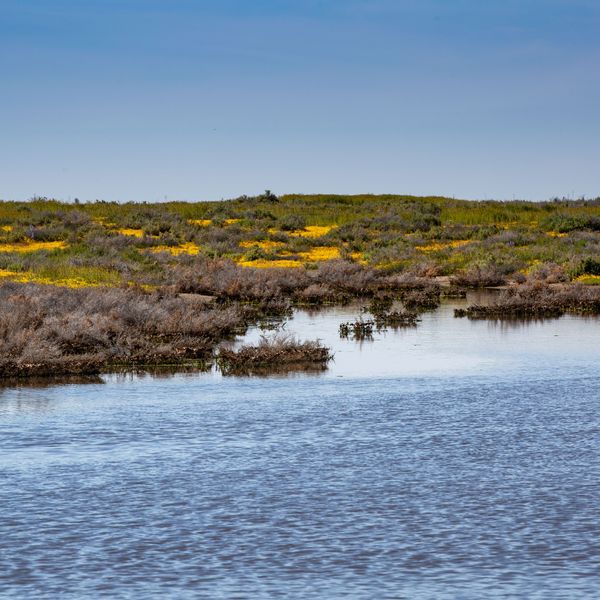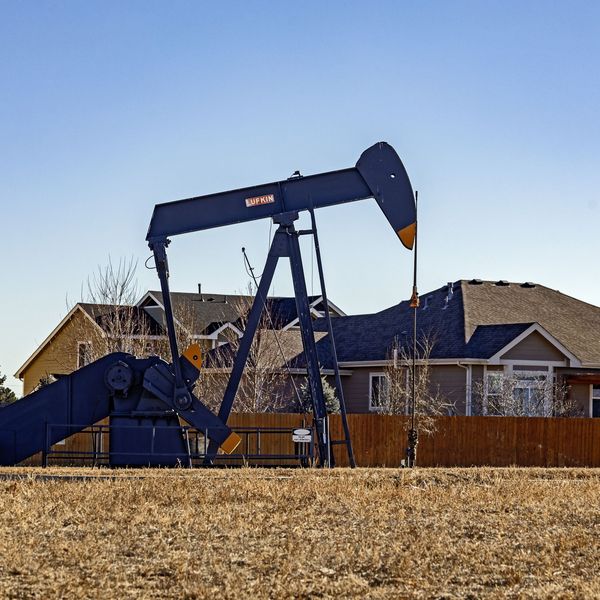
The Clean Water Rule, introduced in 2015, aimed to reduce pollution from substances like chemical fertilizers used by farmers and ranchers, in 60 percent of U.S. waterways. (Photo: EcologyWA)
In Latest 'Giveaway to Polluters', Trump EPA Suspends Clean Water Rule
Rescinding the regulation will put the drinking water of one in three Americans in danger of pollution, critics say
In a decision that critics warned will put the drinking water of one in three Americans at risk, the Environmental Protection Agency (EPA) announced plans on Wednesday to suspend the Obama-era Clean Water Rule, meant to limit the flow of chemicals into the nation's waterways.
"Communities across our country can't just 'suspend' their need for clean water any more than they can suspend their need for the sun to come up, which makes this ridiculous giveaway to polluters all the more galling," said Dalal Aboulhosn, the Sierra Club's deputy legislative director for land and water.
Also known as the Waters of the United States Rule, the Clean Water Rule was introduced in 2015 and meant to go into effect in the coming weeks, barring farmers and developers from using pollutants including fertilizers that run off into waterways.
President Barack Obama's EPA aimed to protect 60 percent of the nation's water with the regulation, including wetlands, large bodies like the Chesapeake Bay and the Puget Sound, and streams and rivers that flow into them.
President Donald Trump has criticized the rule since his 2016 campaign, calling it "one of the worst examples of federal regulation."
In its statement on the EPA's move, the Sierra Club noted that the rule "was created after the EPA held more than 400 meetings with stakeholder groups across the country... The rule's strong grounding in the Clean Water Act and reliance on the significant scientific evidence showed the need for strong and clear protections against pollution in America's rivers, lakes, and waterways to protect families from dangerous toxins in their water."
As word of the potential suspension of the rule spread last year, Food & Water Watch called the news "another clear signal that the Trump administration cares little for the health and safety of communities across the United States."
"Although far from perfect, the Clean Water Rule was a step in the right direction; now Trump wants to take giant steps backwards in clean water protections, back to the days of massive fish kills and rivers on fire," said executive director Wenonah Hauter. "With each day in office, Trump is firmly cementing his place in history as the worst environmental president to ever hold office."
An Urgent Message From Our Co-Founder
Dear Common Dreams reader, The U.S. is on a fast track to authoritarianism like nothing I've ever seen. Meanwhile, corporate news outlets are utterly capitulating to Trump, twisting their coverage to avoid drawing his ire while lining up to stuff cash in his pockets. That's why I believe that Common Dreams is doing the best and most consequential reporting that we've ever done. Our small but mighty team is a progressive reporting powerhouse, covering the news every day that the corporate media never will. Our mission has always been simple: To inform. To inspire. And to ignite change for the common good. Now here's the key piece that I want all our readers to understand: None of this would be possible without your financial support. That's not just some fundraising cliche. It's the absolute and literal truth. We don't accept corporate advertising and never will. We don't have a paywall because we don't think people should be blocked from critical news based on their ability to pay. Everything we do is funded by the donations of readers like you. Will you donate now to help power the nonprofit, independent reporting of Common Dreams? Thank you for being a vital member of our community. Together, we can keep independent journalism alive when it’s needed most. - Craig Brown, Co-founder |
In a decision that critics warned will put the drinking water of one in three Americans at risk, the Environmental Protection Agency (EPA) announced plans on Wednesday to suspend the Obama-era Clean Water Rule, meant to limit the flow of chemicals into the nation's waterways.
"Communities across our country can't just 'suspend' their need for clean water any more than they can suspend their need for the sun to come up, which makes this ridiculous giveaway to polluters all the more galling," said Dalal Aboulhosn, the Sierra Club's deputy legislative director for land and water.
Also known as the Waters of the United States Rule, the Clean Water Rule was introduced in 2015 and meant to go into effect in the coming weeks, barring farmers and developers from using pollutants including fertilizers that run off into waterways.
President Barack Obama's EPA aimed to protect 60 percent of the nation's water with the regulation, including wetlands, large bodies like the Chesapeake Bay and the Puget Sound, and streams and rivers that flow into them.
President Donald Trump has criticized the rule since his 2016 campaign, calling it "one of the worst examples of federal regulation."
In its statement on the EPA's move, the Sierra Club noted that the rule "was created after the EPA held more than 400 meetings with stakeholder groups across the country... The rule's strong grounding in the Clean Water Act and reliance on the significant scientific evidence showed the need for strong and clear protections against pollution in America's rivers, lakes, and waterways to protect families from dangerous toxins in their water."
As word of the potential suspension of the rule spread last year, Food & Water Watch called the news "another clear signal that the Trump administration cares little for the health and safety of communities across the United States."
"Although far from perfect, the Clean Water Rule was a step in the right direction; now Trump wants to take giant steps backwards in clean water protections, back to the days of massive fish kills and rivers on fire," said executive director Wenonah Hauter. "With each day in office, Trump is firmly cementing his place in history as the worst environmental president to ever hold office."
In a decision that critics warned will put the drinking water of one in three Americans at risk, the Environmental Protection Agency (EPA) announced plans on Wednesday to suspend the Obama-era Clean Water Rule, meant to limit the flow of chemicals into the nation's waterways.
"Communities across our country can't just 'suspend' their need for clean water any more than they can suspend their need for the sun to come up, which makes this ridiculous giveaway to polluters all the more galling," said Dalal Aboulhosn, the Sierra Club's deputy legislative director for land and water.
Also known as the Waters of the United States Rule, the Clean Water Rule was introduced in 2015 and meant to go into effect in the coming weeks, barring farmers and developers from using pollutants including fertilizers that run off into waterways.
President Barack Obama's EPA aimed to protect 60 percent of the nation's water with the regulation, including wetlands, large bodies like the Chesapeake Bay and the Puget Sound, and streams and rivers that flow into them.
President Donald Trump has criticized the rule since his 2016 campaign, calling it "one of the worst examples of federal regulation."
In its statement on the EPA's move, the Sierra Club noted that the rule "was created after the EPA held more than 400 meetings with stakeholder groups across the country... The rule's strong grounding in the Clean Water Act and reliance on the significant scientific evidence showed the need for strong and clear protections against pollution in America's rivers, lakes, and waterways to protect families from dangerous toxins in their water."
As word of the potential suspension of the rule spread last year, Food & Water Watch called the news "another clear signal that the Trump administration cares little for the health and safety of communities across the United States."
"Although far from perfect, the Clean Water Rule was a step in the right direction; now Trump wants to take giant steps backwards in clean water protections, back to the days of massive fish kills and rivers on fire," said executive director Wenonah Hauter. "With each day in office, Trump is firmly cementing his place in history as the worst environmental president to ever hold office."

